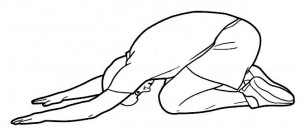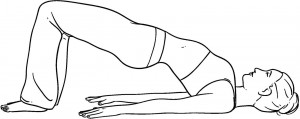
One of the most difficult things we all face at some time in our lives is deciding to implement, and then actually stick to an exercise program. This undertaking is hard enough for a healthy individual, but it borders on seemingly impossible for someone who suffers from Adrenal Fatigue.
However, if you have Adrenal Fatigue you may also find that you want to exercise constantly because it gives you that energy and surge of adrenaline afterwards that makes you feel good albeit only temporarily. The truth however is that exercising too much and too strenuously can actually hurt your body and prevent you from feeling better and getting healthy. If you are worried that slowing down or even stopping your exercise routine is going to cause you to gain weight, you don’t need to worry. As any nutritionist will tell you, losing weight is 80% about what you eat and 20% about exercise.
So if you want to lose weight it is always better to focus your attention towards what you are eating first instead of adopting an exercise routine. Please note that exercising too much and too strenuously works counterproductive in the long run if you have Adrenal Fatigue. In such cases the workout acts as a stressor that puts a lot of stress on the body which causes your adrenal glands to release cortisol, which will then encourage your body to store fat – especially around your belly area.
FREE Stress Management Workbook
YES, I want to learn to manage my stress and heal from Adrenal Fatigue
Good Exercise
Exercise is important and it can go a long way toward improving your health, so even if you have Adrenal Fatigue you should still engage in some sort of exercise or physical activity. You just want to avoid workouts that are likely to stress your body, such as workouts that are high intensity, leave you gasping for breath or workouts that leave you completely drained at the end. You want to do exercises that are much more gentle on the body. Do not worry about the amount of calories that these exercises do or do not burn.
There are many types of workouts that you can gradually increase the intensity of as your Adrenal Fatigue improves. These include: walking, swimming, yoga, meditation, tai chi and stretching. These forms of exercise are great for staying active and promoting a healthy body, even for someone with Adrenal Fatigue. A good exercise is one that you can still have a conversation while doing it. It is keeping the body moving but not at pace where you are gasping for breath and can’t focus enough to talk to a person next to you. It may even surprise you to find out that weight training can also be incorporated into an Adrenal Fatigue exercise regime.
There are numerous differing schools of thought regarding the best type of exercise for Adrenal Fatigue sufferers to engage in. Alissa Vitti, author of Woman Code, supports the position that vigorous physical activity which extends for long periods of time is actually a contributor to increased adrenal hormone production, thus exacerbating Adrenal Fatigue. Her recommended method of coping with the condition is to fashion an exercise regimen that focuses on limited bursts of non-strenuous exercise.
Her favorites are walking or light jogging. These exercise sessions should be limited to 20 minutes each and repeated three or four days per week, as your tolerance allows.
Most authorities on Adrenal Fatigue agree that walking is one of the best exercise treatments. If you find yourself too exhausted for an outside stroll, simply walking around the house several times through the day is a viable alternative.
Legs Up The Wall Pose (Viparita Karani)
Roger Cole, a columnist for Yoga Journal and a yoga teacher, was asked to recommend a yoga move to help alleviate the symptoms of Adrenal Fatigue. Cole recommends the “Legs Up the Wall Pose” as an easy way to begin combatting this chronic fatigue syndrome. Performing the pose is simple and can be done in the privacy of your home.
To begin, clear a space on the floor near a wall. Lie on your back so that the edge of your buttocks is touching the wall. If you are more comfortable with your hips slightly elevated, using a pillow or yoga bolster is fine. The goal is to fully extend your legs up the wall, so you need to “walk” your feet up the wall until your legs are extended.
If you find this position uncomfortable, try placing the soles of your feet against the wall. Once you have found a comfortable position, hold it from two to fifteen minutes, if possible. Don’t strain yourself but do try to maintain the pose as long as you can.

Corpse Pose (Savasana)
A second restorative, relaxing and very gentle asana for Adrenal Fatigue is the Corpse Pose or Savasana. It is the most calming and relaxing of all yoga poses and brings the body in a state of deep rest and relaxation. This yoga pose helps in promoting sleep, lowering blood pressure and calming the nervous system.
Lie down on the floor on your back with any cushion or pillow for support. Place your arms on the side of your body, your palms open and facing the ceiling. Keep your feet slightly apart and relax your knees and toes. Close your eyes and consciously relax all the muscles in your body from head to toe. Let your breathing be slow and deep and focus your attention on your belly and observe your slow and rhythmic abdominal breathing.
You can maintain this position for as long as you need ranging from 5 – 30 minutes. Make sure you don’t sleep during the process. To release this position, take a few deep breaths and slowly roll over to the side. Use your arms and raise yourself to the seated position.

Simple Yoga Poses You Can Do At Home
The soothing nature of restorative yoga can reverse the hyperactivity of the senses, allowing the mind and the nervous system to stop reacting to external stimuli and focus instead on the workings of the inner body. Senses can focus on breathing or for example on specific areas feeling tension. Anxiety levels can be lowered by these asanas (asana = pose or posture used in the practice of yoga) and the perpetual fight-or-flight state that a person is in can be soothed.
If you suffer from deep, on-going fatigue, something as simple as standing up for even a short amount of time can become an exhausting undertaking. The entire body can assume an unhealthy posture, such as stooping shoulders. The spine will sag, compressing the chest and the diaphragm. This causes shallow breathing and a tightness in the abdomen.
It is very difficult to practice the relieving measures of a yoga asana under these conditions. Luckily, there are props that can be used in a restorative practice, such as blankets, blocks, belts, and bolsters.
These simple tools can, for example, support your body through passive backbends that allow your chest to expand. This opens the body and the mind to the restorative effects of the yoga pose in a passive motion that won’t deplete already low reserves.
While the Legs Up The Wall Pose and the Corpse Pose are great relaxing, gentle and restorative exercises, following two simple asanas are a great way to strengthen and stretch your muscles, improve your posture and get some exercise. It is suggested that each be held for about 30 seconds to 1 minute, depending on your tolerance. Repeat it 5-6 times. If you experience pain or feel like you’re straining to hold any pose, then stop or reposition yourself to alleviate the problem and gradually build your tolerance to the pose.
Child Pose (Balasana)
The Child Pose or Balasana is very relaxing yoga pose that helps in calming the mind and replenishing the body with energy. It relaxes the spine shoulders and neck, relieving lower back pain, hip strain and shoulder and neck stiffness. It has a healing and restorative power that helps in giving mental and emotional relief.
Begin by kneeling on a yoga mat or floor and bring your knees together while resting your buttocks on your feet. Now, slowly begin to walk your palms out in front of you, folding forward and allowing your chest to come between your thighs. Drop your hips toward your heels, and allow your forehead to come down and rest on the mat. Feel the stretch in your spine. Close your eyes, steady your breathing and allow a deeper level of relaxation. Imagine your spine lenghtening and widening with each inhalation. While you exhale, fall deeper into relaxation, allowing the stretch to release a little more tension with each breath.
Hold the position for 30 seconds to 1 minutes breathing regularly. To come out of the pose, use an inhale to slowly begin to walk your torso back into an upright position. This makes one repetition. Repeat it 5 to 6 times.
Please note: If you have weak knees or other knee problems, you should perform the Child Pose with care.

Bridge Pose (Setu Bandha Sarvangasana)
The bridge pose (Setu Bandha Sarvangasana) is an excellent yoga pose to calm the brain, reduce stress, anxiety and depression. It helps in stretching the muscles of the spine, neck and chest and the leg and is an effective exercise for strengthening the thighs, hips and back. In addition, it also helps in controlling high blood pressure , improves digestion, headaches, sleep disorders and fatigue.
To begin, lie flat on the floor or yoga mat and bend your knees so that your feet are close to the buttocks. Your feet should be placed hip distance apart on the floor, about 10 inches from your pelvis, with your knees and ankles in a straight line. Now, inhale and slowly lift your hips upward by pressing your arms on the floor and lift your breastbone too while keeping your head fixed facing to the ceiling. Remain in the position for 30 seconds to 1 minute and exhale as you gently release the pose. This makes 1 repetition. Repeat it 5 to 6 times.
Avoid doing the Bridge Pose if you are suffering from neck and back injuries.

http://www.yogajournal.com/article/practice-section/treating-adrenal-exhaustion/ (2007)
https://www.jenreviews.com/yoga/
Weight Training
When you do weight training it does not affect your heart or breathing processes that intensely. It can build muscle mass which is good for the body because it will help improve circulation and increase metabolic rate. This is especially good for those suffering from Adrenal Fatigue because it increases the flow of energy throughout the body and this is typically what people suffering from Adrenal Fatigue are lacking and wish to recover.
Before you get winded you want to know the limits of your body and what you can and cannot do. You do not want to over exert yourself because this can put too much strain on your adrenal glands. Use light weights or just body weight and do slow easy movements. This will prevent you from exerting yourself and you will be able to stop before you strain your body too much. You do not want to work out with weights that are very heavy and cause you to strain to lift them. This will send stress signals to your body which will then put pressure on your fatigued adrenal glands and cause them to crash. So make sure you choose light weights and stop when you feel your body straining too much.
Experts agree that whatever exercise regimen you choose, it must be balanced. For those suffering from Adrenal Fatigue, the power lifting is not a feasible option but a routine of light resistance training can be beneficial. Any exercise that forces your muscles to work against a resistance is acceptable as long as it doesn’t place you under undue stress.
Some examples of low stress resistance training exercises are swimming or riding a bicycle. Lifting weights can be done but remember to go slow; don’t begin by trying to bench press a couple hundred of pounds and if you want to lift weights, you should try to devote equal attention to all of the major muscle groups.
Use lifting exercises that work the legs and buttocks, the core and back, and the chest and arms. It is recommended that weight lifting only be done for a maximum of 20 minutes in sessions on two days per week.

Why Exercising Is Good For You
Human beings were designed to move, not sit behind an office desk. So exercise is a crucial part of good body function. Whether you are walking, swimming or lifting weights, all types of exercise relaxes tense muscles and tissue. These can strongly contribute to stress-related aches and pains such as neck or back pains and headaches.
Exercising helps circulate blood and oxygen through the body and toxins out of the body, which improves your overall energy flow. Not to mention that it will also stimulate the release of both serotonin and endorphins which affect your mood, energy levels and overall well-being. This helps combat the negative effects of stress.
Exercise also helps you to shed the daily tensions and you may find that this focus on a single task results in higher energy levels and optimism that can help you feel clearer and calmer in everything you do. You not only become completely absorbed in what you are doing at the time, but the positive endorphins that exercise releases will also help you maintain a more positive outlook afterwards.
As with everything balance is key – you want to limit yourself so as not to overstimulate your adrenal glands but you should also strive for a workout that reduces your stress.
Enjoy Yourself
The most important thing for sufferers of Adrenal Fatigue to remember is that this condition is a result of constant, sustained stress on the body. So it is important that you do not put your body under even more stress when exercising. Pay attention to how your body is feeling as you exercise. If you feel your energy level plummeting, your body is telling you that it’s time to stop for now. Rest for one or two days, then gradually resume your exercise regimen. As always, consult your personal doctor before starting any exercise program.
You should not be thinking that exercise is just limited to things you can do in a gym or things that strictly considered workouts. There are other ways that you can stay active and reap the benefits of exercise without feeling like you are doing exercise. Things like dancing or gardening or just playing with your kids. These have the same benefits of exercise without the risk of straining yourself and they will definitely help improve your mood. They will also promote relaxation and peace instead of the stress that can sometimes be accompanied with exercise.
Develop An Exercise Plan
There’s no “one-size-fits-all” kind of an approach when it comes to developing an exercise plan, considering that a plan should be developed around a person’s biology, age, goals, diet, free time, and other variables. But it is highly recommended to at least work through following 3 steps before you get started:
(Again you need to make sure that you talk with a healthcare professional before starting any exercise program, this is especially true for those with Adrenal Fatigue)
1. Assess Your Starting Point
Although you might have some rough idea of how fit you are, assessing and recording baseline fitness scores can give you a benchmark against which you can measure your progress. To assess your overall fitness consider recording:
- Your pulse rate before and after you walk 1 mile (1.6 kilometers)
- How long it takes to walk 1 mile (1.6 kilometers)
- How many pushups you can do at a time
- How many situps can you do at a time
- How far you can reach forward while standing straight. Can you reach your toes?
- Your waist-to-hip ratio. Use a tape measure to record your waist and hip circumference. Then divide your waist circumference by your hip circumference
- Whether you can hold an abdominal plank position for 2 minutes
2. Develop Your Exercise Program
It’s easy to say that you are going to exercise 3 days a week, but you’ll still need a plan. As you develop your exercise program, keep these points in mind:
- Consider your goals
- Create a balanced routine
- Go at your own pace
- Plan to include different activities
- Allow time for rest and recovery
- Put it in a plan
3. Get Started & Monitor Your Progress
Now you’re ready to get started. As you begin your exercise program, keep these tips in mind:
- Start slowly and build things up gradually
- Break things up if you have to
- Listen to your body!!!
- Reexamine your personal fitness and progress on a regular basis
- Enjoy what you do
Final Thoughts
The key to exercising with Adrenal Fatigue is to listen to your body. Stop exercising when you feel your body struggling to keep up but get right back at it the next day or the day after should you need a rest day. Make sure you get plenty of rest, always sleep when your body is telling you that you need it. You should also make sure you stay well hydrated, especially throughout your workouts. All of the gentle exercises mentioned here are safe and gentle enough that even someone with Adrenal Fatigue should be able to do them. So even if you have an exercise addiction you can keep to it by engaging in gentle activities such as walking, swimming and yoga in order to give your adrenal glands the support to repair themselves.













